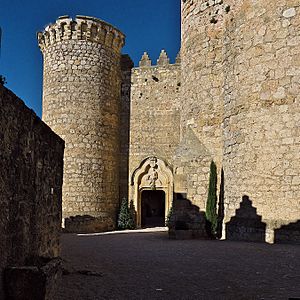Castle of Belmonte (Cuenca) facts for kids
The Castillo de Belmonte is a famous medieval castle in Spain. It stands proudly on San Cristobal hill, just outside the village of Belmonte in the Cuenca region. This historic building was officially recognized as a national treasure on June 3, 1931. Today, it is a protected site known as a Bien de Interés Cultural, which means it's a very important cultural landmark.
History of Belmonte Castle
The castle was built in the second half of the 1400s. A powerful man named Don Juan Pacheco, who was the first Marquis de Villena, ordered its construction. This was a time when the Kingdom of Castille had many disagreements and small conflicts. Pacheco wanted to make his lands stronger and build forts to protect them before bigger problems started.
It's believed that Juan Guas was the architect for the castle. He had already worked for Pacheco on another project, the Monastery of Santa María del Parral. Construction began in 1456, but the castle was not fully finished when Pacheco died. His son, Diego Lopez de Pacheco, did some work to continue his father's plans. However, he mostly didn't pay much attention to the fortress.
Abandonment and Restoration
The castle was mostly left empty during the 1600s and 1700s. By the early 1800s, it was almost a ruin. But then, a very important person stepped in! The heiress of the Villena family was Eugenia de Guzman, who later became famous as Empress Eugenia de Montijo.
In 1857, Empress Eugenia and her architect, Alejandro Sureda, started a big project to restore the castle. They kept the outside looking like the original medieval style. However, they updated the inside to fit modern tastes. For example, Sureda used bricks for new indoor walkways that looked over the main courtyard. Empress Montijo spent a lot of money on this project, more than 500,000 pesetas. The restoration work stopped in 1870 when the Second French Empire ended.
Later Uses and Modern Day
After the restoration, the castle was used as a French Dominican monastery for several years. When the Dominicans left, the empress's great-nephew, Hernando Fitz-James Stuart e Falco, who was the Duke of Penaranda, continued the restoration work. He even lived in the castle for a while.
Later, the castle served different purposes. It was used as a prison for the Belmonte area. It also became an academy for a group called the 'Frente de Juventudes' during the time of Onésimo Redondo. After these uses, the castle was abandoned again and started to fall apart.
Thankfully, in 1931, it was declared a cultural monument, which helped protect it. Today, the castle is owned by the family members who are descendants of the empress's sister, Maria Francisca de Sales Portocarrero. In the summer of 2010, the castle was restored once more. Now, it is open to the public, and visitors can explore its rich history!
See also
 In Spanish: Castillo de Belmonte para niños
In Spanish: Castillo de Belmonte para niños



